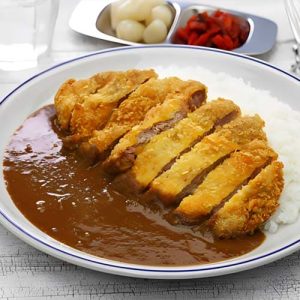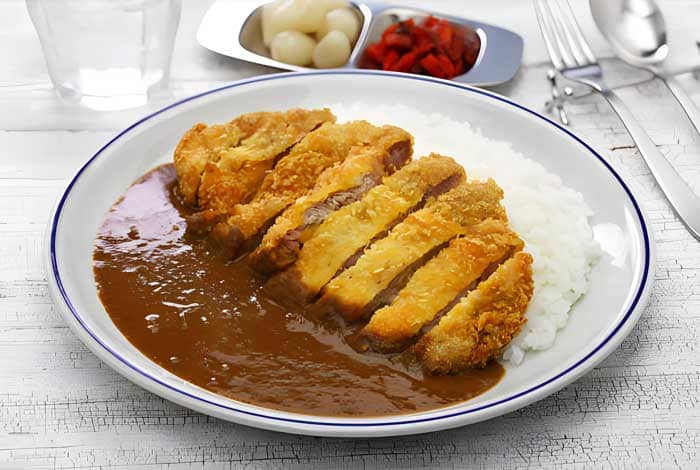Introduction to Katsu Curry
Origins and Popularity
Katsu Curry, a dish that seamlessly blends the Western concept of fried food with the Eastern flavors of curry, has its roots deeply embedded in Japanese culinary history. Originating in the Meiji era, it was a time when Japan was embracing Western influences, and the Katsu Curry emerged as a symbol of this new, hybrid cuisine. Initially, it started as tonkatsu – a breaded, deep-fried pork cutlet, which was then paired with the rich, mildly spiced curry sauce, a British-influenced adaptation of Indian curry. This fusion dish quickly gained popularity, becoming a staple in Japanese households and restaurants. Its unique combination of textures and flavors – the crunchiness of the breaded cutlet and the smooth, hearty curry – made it a beloved comfort food across Japan. For an in-depth look at the history of curry in Japan, visit Japan Info.
Cultural Significance in Japan
In Japan, Katsu Curry is not just a dish; it’s a cultural phenomenon. It represents more than just the fusion of culinary traditions; it embodies the adaptability and innovation of Japanese cuisine. Often served in family restaurants and school cafeterias, it has become a part of the everyday diet, symbolizing a sense of nostalgia and comfort for many. On a deeper level, Katsu Curry reflects the Japanese ethos of yoshoku – Western food, Japanese-style. This dish, in its essence, showcases how Japan has embraced and reinterpreted foreign influences, creating something uniquely their own. It’s a testament to the country’s culinary resilience and creativity, making Katsu Curry a significant marker in Japan’s gastronomic landscape. To understand more about Japanese cooking techniques that make dishes like Katsu Curry special, check out Japanese Cooking 101.
Global Appeal
The global appeal of Katsu Curry lies in its universal flavor profile that resonates with a wide audience. Its simplicity, coupled with the comforting richness of curry and the satisfying crunch of fried chicken, transcends cultural boundaries. This dish has found its way onto menus around the world, often becoming an introductory course for those new to Japanese cuisine. Its adaptability to local tastes and ingredients further enhances its worldwide popularity, making Katsu Curry a global favorite.
Ingredients Overview
Katsu Curry is a delightful dish that combines a crispy chicken cutlet with a rich, flavorful curry sauce, served over a bed of steaming rice. Here’s a comprehensive list of ingredients needed to create this culinary masterpiece, along with some alternative options:
- Chicken Cutlets: Typically, boneless chicken breasts are used, pounded to an even thickness for uniform cooking. Alternatives: For a different take, try using pork loin (for tonkatsu) or firm tofu for a vegetarian version.
- Panko Breadcrumbs: These Japanese breadcrumbs are key for achieving the perfect crispy texture. Alternatives: Regular breadcrumbs or gluten-free breadcrumbs can be used for dietary preferences.
- Flour and Eggs: Used for breading the chicken cutlets. Alternatives: Gluten-free flour and egg substitutes like buttermilk or yogurt can be used.
- Curry Powder: This is essential for the curry sauce. Alternatives: A mix of turmeric, coriander, cumin, and chili can replicate the flavor.
- Onions, Garlic, and Ginger: These aromatics add depth to the curry sauce.
- Chicken Stock: Forms the base of the curry sauce. Alternatives: Vegetable stock can be used for a vegetarian curry.
- Carrots and Potatoes: Common vegetables in Katsu Curry. Alternatives: Sweet potatoes or other root vegetables can be a great substitute.
- Cooking Oil: For frying the cutlets. Alternatives: Any high-smoke-point oil like canola or vegetable oil works well.
- Rice: Served as a base for the curry. Alternatives: Brown rice or quinoa for a healthier option.
Preparing the Chicken Cutlet
Creating the perfect Chicken Cutlet for your Katsu Curry involves a few simple steps:
- Prepare the Chicken: Start by taking boneless chicken breasts and pounding them to an even thickness. This ensures even cooking and a tender cutlet.
- Seasoning: Lightly season the chicken with salt and pepper. This step is crucial for adding flavor to the meat.
- Breading Station Setup: Arrange three shallow dishes – one with flour, one with beaten eggs, and one with panko breadcrumbs. This setup will streamline the breading process.
- Dredging in Flour: Coat each chicken breast in flour, shaking off any excess. The flour helps the egg mixture adhere to the chicken.
- Egg Wash: Dip the floured chicken into the beaten eggs, ensuring it’s fully coated. The egg acts as a glue for the breadcrumbs.
- Breading with Panko: Finally, press the chicken into the panko breadcrumbs, making sure it’s evenly coated. Panko gives the cutlet its signature crunch.
- Frying the Cutlets: Heat oil in a large skillet over medium heat. Once hot, add the breaded chicken cutlets. Fry each side until golden brown and cooked through, usually about 3-4 minutes per side.
- Resting: After frying, let the cutlets rest on a wire rack for a few minutes. This step ensures the cutlets retain their crispiness.
- Slicing: Slice the cutlets into strips before serving. This makes it easier to eat and allows for more surface area to be covered with the delicious curry sauce.
Following these steps will yield perfectly crispy and juicy chicken cutlets, ready to be paired with the savory curry sauce and rice, completing your Katsu Curry experience.
Making the Curry Sauce
Creating the perfect curry sauce for Katsu Curry involves a blend of aromatic spices and vegetables, simmered to achieve a rich and flavorful sauce. Here’s how to make it:
- Sauté Aromatics: Begin by heating a tablespoon of oil in a large saucepan. Add finely chopped onions, minced garlic, and grated ginger. Sauté these ingredients over medium heat until the onions become translucent and slightly golden, which usually takes about 5-7 minutes.
- Add Spices: Stir in two tablespoons of curry powder, allowing the spices to cook for a minute. This step helps release the flavors of the spices, infusing the oil and onions with a deep, aromatic scent.
- Create a Roux: Sprinkle in two tablespoons of flour, stirring constantly. Cook for a couple of minutes until the flour is well incorporated with the oil and spices, forming a thick paste. This roux will thicken the curry sauce.
- Add Liquids: Slowly pour in four cups of chicken or vegetable stock, whisking continuously to avoid lumps. Add diced carrots and cubed potatoes.
- Simmer: Bring the mixture to a boil, then reduce the heat and let it simmer. Cover the saucepan and cook for about 20 minutes, or until the vegetables are tender.
- Adjust Seasonings: Taste the curry and adjust the salt and spices as needed. If the sauce is too thick, add a little more stock or water to reach the desired consistency.
- Final Touch: For an extra depth of flavor, you can add a dash of soy sauce or Worcestershire sauce.
Assembling the Dish
Once the curry sauce and chicken cutlets are ready, it’s time to assemble the dish:
- Prepare the Rice: Serve a portion of steamed rice on one side of the plate.
- Add the Cutlet: Place the crispy chicken cutlet next to the rice.
- Pour the Curry: Generously ladle the curry sauce over the chicken cutlet, allowing some to spill onto the rice.
- Garnish: For a final touch, garnish with pickled radish or a sprinkle of chopped green onions.
Presentation Tips:
- Use a wide plate to give each component of the dish its space.
- Slice the chicken cutlet neatly for a visually appealing presentation.
- Garnish with bright colors like green onions or red pickles to contrast the rich color of the curry.
Cooking Tips and Tricks
To ensure your Katsu Curry turns out perfectly every time, consider these expert tips:
- Quality of Ingredients: Use fresh, high-quality ingredients, especially for the chicken and spices. Freshly ground spices will give a more vibrant flavor to the curry.
- Consistency of the Sauce: The curry sauce should be thick enough to coat the back of a spoon. If it’s too thin, simmer for a longer time; if too thick, add more stock.
- Balancing Flavors: The key to a great curry is balancing the spices. Don’t be afraid to adjust the amount of curry powder or add a bit of sugar if the sauce is too spicy.
- Cooking the Chicken: Ensure the oil is hot enough before frying the chicken cutlets. They should sizzle as soon as they hit the pan, ensuring a crispy exterior.
- Resting the Chicken: Allow the fried chicken cutlets to rest for a few minutes after cooking. This helps the juices redistribute, ensuring a moist cutlet.
- Rice Quality: Use short-grain or medium-grain rice for an authentic experience. The stickiness of this type of rice complements the texture of the curry.
- Experiment with Variations: Feel free to experiment with different types of protein like pork or tofu, and add other vegetables like bell peppers or peas to the curry.
By following these detailed instructions and tips, you can create a delicious and authentic Katsu Curry that is sure to impress.
Vegetarian and Vegan Variations
Katsu Curry can be easily adapted for vegetarian and vegan diets without compromising on flavor. Here are some alternatives:
- Protein Substitute: Replace chicken with firm tofu or seitan for a vegan version. For tofu, press it to remove excess water, then follow the same breading and frying process as chicken.
- Vegan Breading: Use plant-based milk mixed with a tablespoon of vinegar in place of eggs for the breading process. Combine with flour and panko as usual.
- Curry Sauce: Ensure the curry powder is vegan (some blends contain animal products). Use vegetable stock instead of chicken stock and add more vegetables like bell peppers, peas, or mushrooms.
- Roux: For the roux, use vegan butter or oil instead of regular butter.
Serving and Pairing Suggestions
Katsu Curry pairs wonderfully with a variety of sides and drinks:
- Sides: Serve with pickled vegetables like radish or cucumber to add a refreshing contrast. A side salad with a light dressing complements the dish’s richness.
- Drinks: Pair with a light Japanese beer or green tea for an authentic experience. For a non-alcoholic option, a chilled barley tea works well.
Storing and Reheating
- Refrigeration: Store the curry sauce and chicken cutlets separately in airtight containers. They can last in the fridge for up to 3 days.
- Freezing: The curry sauce can be frozen for up to a month. Avoid freezing the breaded cutlets as they lose their crispiness.
- Reheating: Reheat the curry sauce on the stove or in the microwave, adding a bit of water if it’s too thick. For cutlets, reheat in the oven to maintain crispiness.
Nutritional Information
A typical serving of Katsu Curry is high in protein and carbohydrates. The chicken cutlet provides a good source of protein, while the curry sauce and rice contribute to the carbohydrate content. This dish can be high in fat, especially if the cutlet is deep-fried. For a healthier version, consider baking the cutlet and using less oil in the curry.
Common Mistakes to Avoid
- Overcooking the Chicken: Avoid frying the chicken cutlets for too long, as they can become dry.
- Curry Sauce Consistency: Be careful not to make the curry sauce too thick or too thin. It should coat the back of a spoon.
- Seasoning: Don’t forget to season each component – the chicken, flour, and curry sauce.
- Oil Temperature for Frying: Ensure the oil is hot enough before frying the cutlets for a crispy exterior.
- Stirring the Curry: Stir the curry sauce regularly while cooking to prevent sticking and burning at the bottom of the pot.
FAQs on Katsu Curry on Katsu Curry Recipe
What makes Katsu Curry unique?
Katsu Curry stands out due to its unique combination of a Western-style breaded and fried cutlet with a rich, spiced Japanese curry sauce. This fusion creates a delightful contrast in textures and flavors – the crispy, savory cutlet pairs perfectly with the smooth, hearty curry. It’s a dish that encapsulates the fusion of different culinary traditions, blending the comfort of a deep-fried schnitzel with the warm, spiced notes of Asian curry.
Can I make Katsu Curry gluten-free?
Yes, Katsu Curry can be adapted to be gluten-free. Use gluten-free panko breadcrumbs for the chicken cutlet and ensure that the flour used for breading and making the roux is gluten-free. Additionally, check that the curry powder and any other sauces (like soy sauce) are certified gluten-free. With these substitutions, you can enjoy a gluten-free version without compromising on taste or texture.
What are some common variations of Katsu Curry?
Katsu Curry is versatile and can be customized in various ways. Common variations include:
- Protein Choice: Using pork (tonkatsu) or beef instead of chicken.
- Seafood Version: Breaded and fried shrimp or fish as an alternative to chicken.
- Spice Level: Adjusting the amount of curry powder or adding chili peppers for a spicier version.
- Vegetarian Options: Using breaded and fried tofu or tempeh instead of meat.
How can I make a vegetarian version of Katsu Curry?
To make a vegetarian version, replace the chicken cutlet with a breaded and fried alternative like tofu, tempeh, or a vegetable cutlet. Use vegetable stock in the curry sauce and add more vegetables like bell peppers, mushrooms, or sweet potatoes. Ensure that the breadcrumbs and other ingredients are vegetarian-friendly.
What are the best sides to serve with Katsu Curry?
Katsu Curry pairs well with a variety of sides. Some popular choices include:
- Pickled Vegetables: Such as radish or cucumber to add a refreshing crunch.
- Salad: A light green salad with a simple dressing to balance the richness.
- Miso Soup: For an authentic Japanese meal experience.
- Steamed Vegetables: Like broccoli or carrots for a healthy addition.
- Rice: A staple side, providing a neutral base for the flavorful curry.

Katsu Curry Recipe
Equipment
- Large skillet or frying pan
- Three shallow dishes for breading
- Saucepan for curry
- Meat mallet (for pounding chicken)
- Kitchen knife and cutting board
- Whisk
Ingredients
For the Chicken Cutlet:
- 4 boneless skinless chicken breasts
- Salt and pepper to taste
- 1 cup all-purpose flour
- 2 large eggs beaten
- 2 cups panko breadcrumbs
- Vegetable oil for frying
For the Curry Sauce:
- 2 tablespoons vegetable oil
- 1 large onion finely chopped
- 2 cloves garlic minced
- 1 tablespoon grated ginger
- 2 tablespoons curry powder
- 2 tablespoons all-purpose flour
- 4 cups chicken or vegetable stock
- 2 carrots diced
- 2 potatoes cubed
- 1 tablespoon soy sauce optional
- Salt and sugar to taste
For Serving:
- Cooked rice
- Pickled vegetables optional
Instructions
Preparing the Chicken Cutlet:
- Pound Chicken: Lightly pound the chicken breasts to an even thickness for even cooking.
- Season: Season both sides with salt and pepper.
- Breading Station: Set up three shallow dishes - one with flour, one with beaten eggs, and one with panko breadcrumbs.
- Coat Chicken: Dredge each chicken breast in flour, dip in egg, and then coat with panko breadcrumbs.
- Fry: Heat oil in a large skillet over medium heat. Fry the breaded chicken until golden brown and cooked through, about 3-4 minutes per side. Drain on paper towels.
Making the Curry Sauce:
- Cook Aromatics: Heat oil in a saucepan. Sauté onion, garlic, and ginger until the onion is soft and golden.
- Add Spices: Stir in curry powder and cook for a minute.
- Make Roux: Add flour and stir well.
- Add Liquids: Gradually add stock, stirring continuously. Add diced carrots and potatoes.
- Simmer: Bring to a boil, then reduce heat and simmer until vegetables are tender and sauce has thickened, about 20 minutes. Season with soy sauce, salt, and sugar.
Assembling the Dish:
- Slice Cutlet: Cut the chicken cutlets into strips.
- Serve: Place a portion of rice on each plate. Top with a chicken cutlet and generously ladle curry sauce over. Serve with pickled vegetables if desired.
Notes
- For a spicier curry, add a pinch of chili powder or cayenne pepper to the curry sauce.
- The chicken cutlet can be baked instead of fried for a healthier option. Bake at 400°F (200°C) for 20-25 minutes or until golden and cooked through.
- Leftover curry sauce can be stored in the refrigerator for up to 3 days or frozen for up to a month.
- Feel free to add other vegetables like bell peppers or peas to the curry sauce for added nutrition.








Leave a Comment